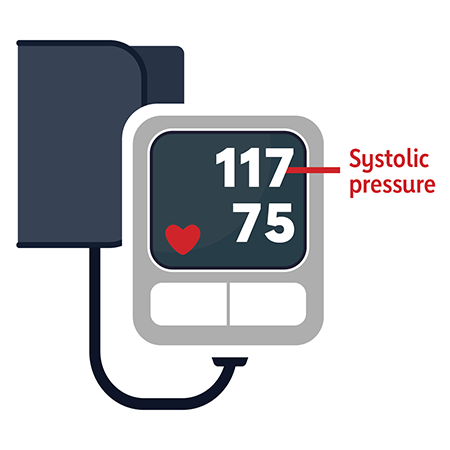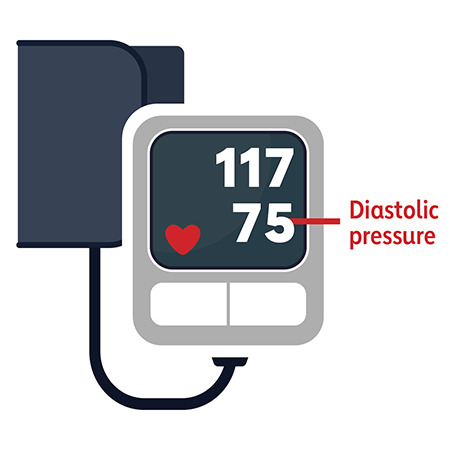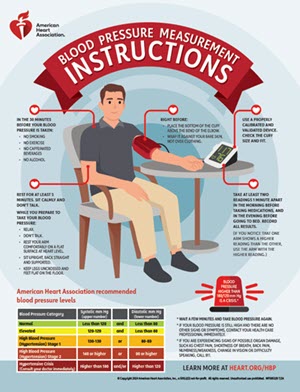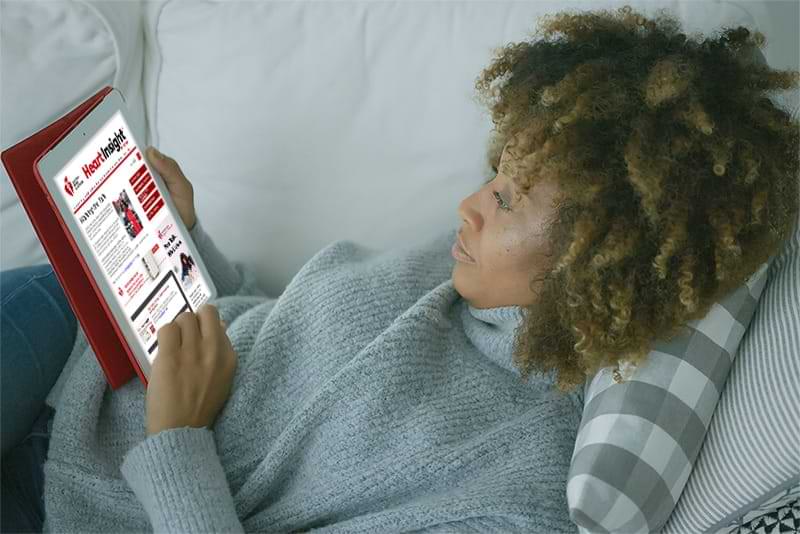Home Blood Pressure Monitoring
Quick Facts
- You should monitor your blood pressure at home if you have been diagnosed with high blood pressure.
- You should use an automatic, upper arm cuff-style monitor.
- Follow the instructions for accurate blood pressure monitoring at home.
Who should monitor blood pressure at home?
The American Heart Association recommends home monitoring for all people with high blood pressure to help their health care professional know if treatments are working. Home monitoring can also be used to confirm the diagnosis of high blood pressure. However, home monitoring does not replace regular doctor visits. Do not stop taking blood pressure medication without checking with your health care professional regardless of your readings during home monitoring.
Monitoring at home is especially important for:
- Anyone diagnosed with high blood pressure.
- People starting or changing high blood pressure treatment to find if it’s working.
- People who need closer monitoring. This is especially true for people with risk factors for high blood pressure and/or conditions related to high blood pressure.
Choosing a home blood pressure monitor
The AHA recommends an automatic, cuff-style, upper arm (biceps) monitor.
- Wrist and finger monitors are not recommended. They give less reliable readings.
- Choose a monitor that has been validated. If you are unsure, ask your health care professional or pharmacist for advice or find options at validatebp.org(link opens in new window).
- When choosing a blood pressure monitor for a senior, person who is pregnant or child, make sure it is validated for them.
- Make sure the cuff fits. Measure around your upper arm and choose a monitor that comes with the correct cuff size.
Once you’ve purchased your monitor, take it to your next appointment.
Have your health care professional check to see that you are using it correctly and getting the same results as the equipment in the office. Plan to bring your monitor in once a year, or as directed by the company, to make sure the readings are accurate.
How to use a home blood pressure monitor
Discuss how to use your home blood pressure monitor with your health care professional. It’s important to have them make sure your home monitor is accurate and that you have the correct cuff size and fit. A cuff that is the incorrect size will cause an inaccurate blood pressure reading.
When preparing to take your blood pressure:
- Plan ahead. Don’t smoke, drink caffeinated beverages or exercise within 30 minutes before taking your blood pressure. Empty your bladder.
- Don't take the measurement over clothes. Remove the clothing over the arm that will be used to measure blood pressure.
- You can use either arm. Usually there is not a big difference between readings on them.
- Be still. Allow at least five minutes of quiet rest before measurements. Don’t talk or use the phone.
- Sit correctly. Sit with your back straight and supported (on a dining chair, rather than a sofa). Your feet should be flat on the floor. Do not cross your legs. Support your arm on a flat surface. The middle of the cuff should be placed on the upper arm at heart level. Check your monitor's instructions for an illustration or have your health care professional show you how.
- Measure at the same time every day. Take the readings at the same time each day. Talk with your health care professional about how often to take your blood pressure.
- Take multiple readings and record the results. Each time you measure, take two readings one minute apart. Record the results using a printable (PDF) tracker. If your monitor has built-in memory to store your readings, take it with you to your medical appointments. Some monitors may also let you upload your readings to a secure website.
Print a sheet that shows you how to measure your blood pressure properly. Also available in Spanish, Traditional Chinese and Simplified Chinese.
Know your numbers
Learn what the numbers in your blood pressure reading mean.
| BLOOD PRESSURE CATEGORY | SYSTOLIC mm Hg (upper number) | and/or | DIASTOLIC mm Hg (lower number) |
|---|---|---|---|
| NORMAL | LESS THAN 120 | and | LESS THAN 80 |
| ELEVATED | 120 – 129 | and | LESS THAN 80 |
| HIGH BLOOD PRESSURE (HYPERTENSION) STAGE 1 | 130 – 139 | or | 80 – 89 |
| HIGH BLOOD PRESSURE (HYPERTENSION) STAGE 2 | 140 OR HIGHER | or | 90 OR HIGHER |
| HYPERTENSIVE CRISIS (consult your doctor immediately) | HIGHER THAN 180 | and/or | HIGHER THAN 120 |
Note: Only a doctor or other medical professional can confirm a high blood pressure diagnosis. They also can evaluate low blood pressure numbers.
Print this chart:
Take Control of Your Blood Pressure
Is your blood pressure in a healthy range? The best way to know is to get it checked.
Then, enter your numbers into this calculator to see which blood pressure category the reading is in.
Systolic Pressure
Diastolic Pressure

Normal Blood Pressure
-
{{item.value}}
Elevated Blood Pressure
-
{{item.value}}
This blood pressure reading is in the elevated range. Unless steps are taken to control it, elevated blood pressure can turn into high blood pressure.
It’s important to recheck your blood pressure with your health care team. They can confirm if this reading is within your target blood pressure range and discuss any steps you might need to take to keep it in a healthy range. Lifestyle changes can help.
High Blood Pressure Stage 1
-
{{item.value}}
High Blood Pressure Stage 2
-
{{item.value}}
Hypertensive Crisis
-
{{item.value}}
This blood pressure reading is in the hypertensive crisis range.
- Wait five minutes.
- Take your blood pressure again.
If your readings are still high, call your health care professional right away.
Call 911 if your blood pressure is higher than 180/120 and you are having chest pain, shortness of breath, back pain, numbness, weakness, change in vision or difficulty speaking.





If you get a high blood pressure reading
- A single high reading is not an immediate cause for alarm. If you get a reading that is higher than normal, take your blood pressure a second time. Write down the results of both measurements. Check with your health care professional to see if there’s a health concern or whether there may be problems with your monitor.
- If your blood pressure readings are suddenly higher than 180/120 mm Hg, wait at least one minute and test again. If your readings are still very high, contact your health care professional immediately. You could be having a hypertensive crisis.
- Call 911 if your blood pressure is higher than 180/120 mm Hg and if you are having new signs or symptoms that may include:
- Chest pain
- Shortness of breath
- Back pain
- Numbness
- Weakness
- Change in vision
- Difficulty speaking
- Confusion
- Dizziness
- Vomiting
Keep a blood pressure journal
One blood pressure measurement is like a snapshot. It tells what your blood pressure is at that moment. A record of readings taken over time provides a more complete picture of your blood pressure. This can help you work with your doctor to make sure that your treatments to reduce your blood pressure are working.







